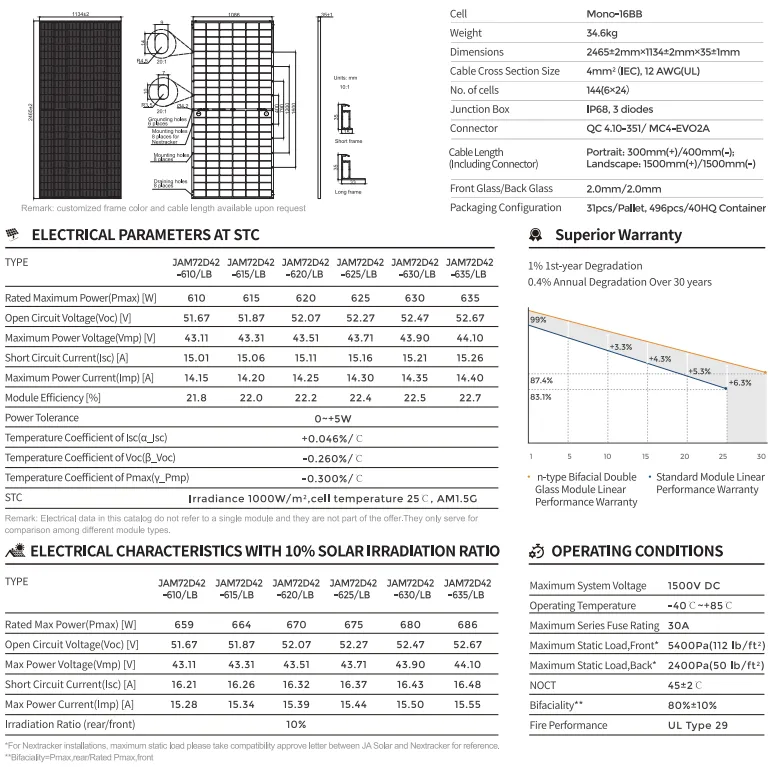Understanding the Relationship Between Solar Panel Dimensions and Their Power Efficiency Output
Solar Panel Size and Power Output Understanding the Relationship
As the world increasingly shifts towards renewable energy sources, solar power has emerged as a leading player in the quest for sustainable energy solutions. The efficiency of solar power systems largely depends on various factors, among which the size of solar panels and their corresponding power output are critical. Understanding the relationship between these two elements is essential for individuals and businesses looking to harness solar energy effectively.
What Determines Solar Panel Size?
Solar panels come in various sizes and configurations, typically measured in terms of square feet or meters. The size of a solar panel impacts its capacity to capture sunlight and convert it into usable electrical energy. The most common solar panels for residential use typically measure about 65 inches by 39 inches, with a surface area of around 17.6 square feet (1.6 square meters). However, larger panels are also available, especially for commercial applications, where space is less of a constraint.
The physical size of the solar panel is not the only factor to consider; the technology employed also plays a vital role. Monocrystalline, polycrystalline, and thin-film solar panels each have unique characteristics and efficiencies. Monocrystalline panels are renowned for their high efficiency and power output per square foot but come at a premium price. Polycrystalline panels are generally less expensive but offer slightly lower efficiency. Thin-film panels, while lightweight and flexible, typically require more space to achieve the same power output due to their lower efficiency.
Power Output Understanding Watts
Power output from solar panels is measured in watts (W), which indicates how much energy can be produced under ideal conditions. The power output of a solar panel is influenced by its efficiency rating, which indicates how effectively it converts sunlight into electricity. For instance, a typical monocrystalline solar panel might have an efficiency rate of around 20% to 22%, while polycrystalline panels generally range from 15% to 18%.
solar panel size and power output

The total power output is calculated by multiplying the panel's nominal power rating (in watts) by the number of panels installed. For instance, if a household installs ten 300-watt panels, the total potential output would be 3,000 watts, or 3 kilowatts (kW). This power output is crucial for determining whether a solar power system can meet a home’s energy needs.
The Interplay Between Size and Power Output
The relationship between solar panel size and power output is direct but not straightforward. Larger panels can typically produce more energy, assuming they have similar efficiency ratings to smaller panels. However, the placement and orientation of the panels, local climate, and shading from nearby structures also significantly affect energy production.
For example, consider two solar installations with the same number of panels but different sizes. The larger panels may produce more electricity per panel due to a higher wattage rating but may not necessarily yield better results if they are not optimally placed. Moreover, space limitations can dictate the size and number of panels that can be installed, influencing the overall energy production from a solar setup.
Conclusion
In conclusion, when considering solar panels for energy generation, understanding the relationship between panel size and power output is crucial for making informed decisions. Larger panels with higher efficiency ratings can yield greater power output, but factors like installation conditions and local weather patterns must also be taken into account. As technology advances and more efficient solar panels become available, the potential for maximizing solar energy production will only continue to grow, making it an exciting time for those looking to invest in renewable energy sources. By carefully evaluating the size and capacity of solar panels, individuals and businesses can make strategic choices that align with their energy needs and sustainability goals.
-
String Solar Inverter: The High-Efficiency Solution for Smart Solar EnergyNewsJul.14,2025
-
Revolutionizing Rooftop Energy with the Power of the Micro Solar InverterNewsJul.14,2025
-
Power Independence with Smart Off Grid Solar Inverter SolutionsNewsJul.14,2025
-
On Grid Solar Inverter: Powering the Future with Smart Grid IntegrationNewsJul.14,2025
-
Monocrystalline Solar Panels: High-Efficiency Power for the Future of Clean EnergyNewsJul.14,2025
-
Bifacial Solar Panel: A Smarter Investment for Next-Generation Energy SystemsNewsJul.14,2025







